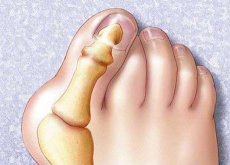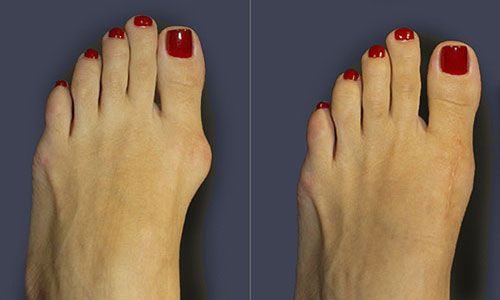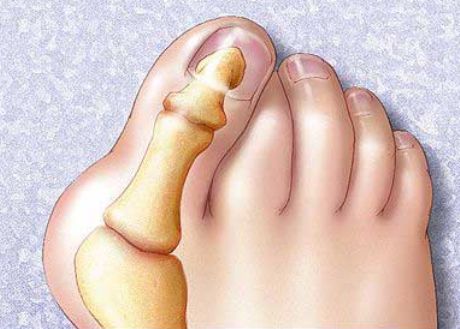Medical expert of the article
New publications
Why do bunions form on my feet?
Last reviewed: 06.07.2025

All iLive content is medically reviewed or fact checked to ensure as much factual accuracy as possible.
We have strict sourcing guidelines and only link to reputable media sites, academic research institutions and, whenever possible, medically peer reviewed studies. Note that the numbers in parentheses ([1], [2], etc.) are clickable links to these studies.
If you feel that any of our content is inaccurate, out-of-date, or otherwise questionable, please select it and press Ctrl + Enter.

Bunions, bunions or hallux valgus are all names for one nasty disease. With this disease, the joint of the big toe is deformed and it can no longer be returned to its previous shape, especially if the disease has progressed to an advanced stage. Why do bunions form on the feet and how can this be prevented?

This is the legacy: bunions on the feet
Many surgeons believe (and not without reason) that bunions can form as a result of hereditary predisposition. If close relatives had a tendency to joint diseases, in particular arthritis, arthrosis, then children and nephews, even grandchildren have the highest risk of developing bunions.
Those at particular risk are those with a hereditary predisposition to hallux valgus, those whose diet is low in calcium, those who are overweight, and those who wear uncomfortable shoes with narrow toes (especially women).
What to do?
Take care of your feet, make up a proper diet and be sure to consult a traumatologist at least once every six months if you are bothered by even slight pain in the joints of your legs.
It is important to remember that the deformation of the ligaments located in the foot is in many cases hereditary, genetically determined. Therefore, you need to take care of them and not overload them if your relatives have had cases of bunions on their feet.
At-risk groups
Teenagers (hormonal changes in the body cause inflammation of the joints and the appearance of bones on the feet)
Pregnant women (hormonal changes and weight gain, which puts pressure on the joints of the foot)
The period of breastfeeding (hormonal storm in the body and a lack of many nutrients in the mother's body, in particular calcium, which is necessary for the development of joints and bone tissue)
The period after menopause (when many hormones are no longer secreted by the body, joints and bones become brittle and fragile, inflamed and painful).
Women involved in the world of fashion and business who are forced to spend most of their time in heels, as well as in tight and uncomfortable shoes
People with "standing" professions - salespeople, teachers, hairdressers, etc. - have increased load on their feet, which is why bones develop on them. Keep in mind that a woman with normal feet without flat feet, who spends up to 8 hours standing, can acquire such an unpleasant disease as flat feet in just a few months.
How are flat feet and the appearance of bunions related?
Flatfoot is a violation of the natural position of the foot. There are three stages - transverse, longitudinal and initial. With transverse flatfoot, the transverse arch of the foot drops. Because of this, the toes begin to diverge like a fan. And their natural position is to be parallel to each other.
When this natural position is disturbed, the toes begin to interfere with each other, to run over each other like carts. At the same time, the big toe - the largest and thickest - with all its weight moves over the other toes, rubs against them and becomes inflamed. Its shape becomes crooked, the head comes out of the joint (true, not all, but partially), and a small bump or bone appears on the toe.
This is the initial process, during which the pain is not yet severe.
Then the big toe moves even more over the other toes. They, protecting themselves from constant friction and pressure, begin to bend inward. This causes the initially weak pain to become stronger, and the person begins to suffer. Now the bunion is no longer just a cosmetic defect, but a real medical problem. But by this point the toes have already gotten used to being in the wrong position, and returning them to their place is a big problem.
Symptoms of Bunions Due to Flat Feet

At first, a slight pain, then a stronger pain, such that it becomes very difficult to wear normal shoes. The bump on the toe prevents normal wearing. The joint becomes swollen and may acquire a reddish tint. The sore joint becomes hard to the touch, similar to a callus.
Symptoms that Predict Bunions on the Legs
Before the bunions are clearly visible, even before they form, you can see the precursor symptoms. This is tiredness of the legs, especially in the evening - and more than usual, tiredness throughout the body, as well as severe swelling of the feet. All these symptoms are especially noticeable in the evening, after a busy day on the feet. They can also be accompanied by redness and calluses on the big toe or on another part of the foot.
If you have found these symptoms, see an orthopedist for an examination so as not to miss a more insidious development of the disease. Such as a bunion.
The reason for the appearance of bones on the legs is extra pounds
Excess weight is a risk factor for those people who develop bunions. Of course, they do not appear on their own. They develop gradually, little by little, and the culprit is the large body mass that presses on the feet, adding almost twice the usual load.
Human feet are huge workers. They bear a weight much greater than all other organs combined. This causes the feet to become flatter, causing the toes to become deformed. If a person also eats improperly, allowing himself fatty, salty, meaty, floury dishes in quantities far from reasonable, this also negatively affects the bone and muscular systems.
Increased weight also means an increased risk of injury from falls, sprains of joints, ligaments and tendons, which is why the foot cannot perform its usual, natural functions. Injuries and sprains provoke an incorrect position of the toes, which can cause a bunion to develop on the feet.
At-risk groups
- People with obesity
- People prone to obesity
- Those with metabolic disorders
- People who constantly have access to fatty, salty, fried foods (for example, cooks)
- People with metabolic disorders
- Those who have a hereditary predisposition to excess weight
- Nursing mothers
- Pregnant women (increases stress on joints)
Other causes of bunions on the feet
These may be concomitant diseases of the joints, feet, foot ligaments. Among these diseases are arthrosis, bursitis, exostosis, inflammation of the metatarsophalangeal joints, osteoporosis.
The development of bunions is also promoted by shoes that are too tight or that are incorrectly cut (we are talking primarily about the shoe last). Wearing high heels, over 4 cm, also provokes the appearance of hallux valgus, since the foot takes an incorrect position and remains in this position for quite a long time.
Causes of the development of bunions include injuries to the legs, shins, feet, and sprains and tendons. These injuries can be acquired at birth or in adulthood.
Bunions can also develop in people who have suffered from severe diseases of the nervous system associated with muscle strain and inflammation. These can be diseases such as cerebral palsy or poliomyelitis.
Whatever the reasons for the appearance of bones on the feet, you need to consult an orthopedic doctor for a consultation at the initial stage of the disease in order to exclude more serious consequences for health.

